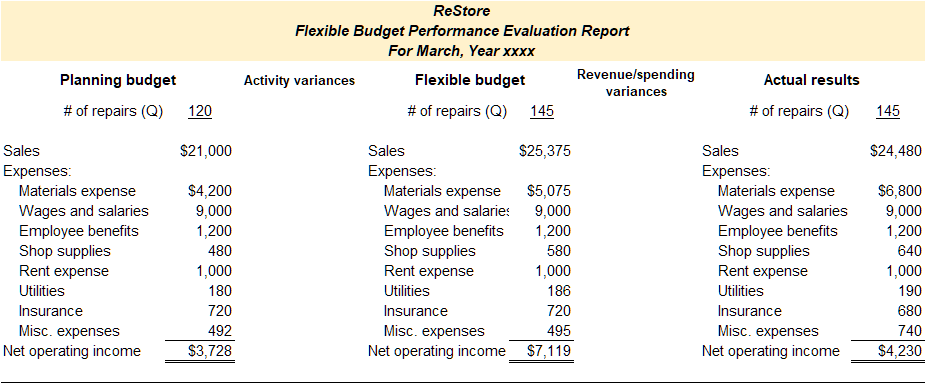6 Flexible Budgeting and Performance Evaluation
Student Learning Objectives:
- Distinguish between planning and flexible budgets
- Prepare a planning budget
- Prepare a flexible budget
- Calculate and analyze activity variances
- Calculate and analyze revenue and spending variances
- Prepare a flexible budget performance evaluation report
Planning budgets
A planning budget is prepared before a flexible budget. A planning budget is a detailed financial plan for future time periods. Planning budgets are prepared before the budgeted period begins. For this reason, the amounts used to create planning budgets are estimates and not actual amounts. Most organizations use historical data and current operating plans to establish the estimates used in planning budgets.
Cost and revenue formulas driven by either expected production or sales are used to compute the amounts forecasted in planning budgets. Estimated sales typically drive revenue, expense, and profit projections for an organization. A cost formula is the expected cost for an expenditure. A revenue formula is the expected revenue for a unit of sales.
Cost and revenue formulas for budgeting are developed based on cost or revenue behavior. Costs and revenues are classified into one of three categories of behavior—variable, fixed, or mixed. Variable costs or revenues are the same amount per unit but the total amount depends on quantity. Fixed costs or revenues are the same in total regardless of quantity but the per unit amount changes depending on the quantity. And mixed costs or revenues have both a variable and a fixed component. Most revenues are considered variable so only costs are discussed in the following category descriptions.
Variable costs. The cost formula for a variable cost is the cost per unit times the quantity driving the cost, usually sales or production. For example, assume that shipping is $4 for every unit sold. Shipping is a variable cost since it is always $4 per unit but the total depends on how many units are sold. The cost formula for shipping would be $4 per unit sold, which is noted as $4Q (Q equals the quantity sold).
Fixed costs. The cost formula for fixed costs is a lump sum amount. For example, assume that rent expense is $2,000 a month. The cost formula for rent would be $2,000 per month in total. However, the per unit charge for rent depends on the quantity sold or produced. For example, if production is 100 units, rent expense is allocated as $2,000 / 100 units = $20 per unit. However, if production is 1,000 units rent expense is allocated as $2,000 / 1,000 units = $2 per unit. Regardless of quantity, the total is always $2,000.
Mixed costs. The cost formula for mixed costs has both a variable and a fixed component. Utilities are a good example of a mixed cost. Typically, utility companies charge a fixed monthly fee plus a charge per unit for the services used. For example, assume that electricity is $50 per month plus $0.25 per kilowatt used. The cost formula for electricity would be $50 plus $0.25 times the quantity used, which is noted as $50 + $0.25Q (Q equals the quantity used).
Video Illustration 1: Preparing a planning budget
Vera, a self-trained chef, opened a new restaurant called Vera’s Vittles in a historic, inner-city neighborhood. Her menu showcases classic Southern dishes passed down from her great grandmother. Since opening approximately two years ago, the restaurant has received rave local reviews and was recently named the best Southern restaurant in the city. At the end of December, Vera wants to prepare a planning budgeted income statement for the upcoming month, January. Her revenue and cost formulas are given in the chart below. Vera estimates approximately 2,000 diners will eat at the restaurant in January. Prepare a planning budgeted income statement for Vera’s Vittles for the month of January.

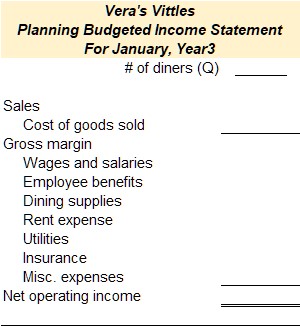

Limitations of planning budgets
Planning budgets are useful in the planning and controlling phases of operations but not as useful for performance evaluation. During the planning phase, these budgets are used by management to help plan operations including activities such as scheduling production, purchasing materials, and making capital investments. During the controlling phase, planning budgets set forth targets for revenue and limitations for spending.
It is usually not appropriate to use a planning budget during the performance evaluation phase of operations. The reason is that the actual quantity sold or produced is rarely the same as the estimated quantity projected in the planning budget. Performance evaluation occurs at the end of the budget cycle and is the process of comparing the budgeted estimates to the actual results. While planning budget quantities are usually close to actual results, it is nearly impossible to accurately predict what the actual sales quantity will be before the period begins. If the planning budget and actual results are based on different sales quantities, they cannot be directly compared. For example, if the actual quantity sold at the end of the period is higher than the budgeted amount, it makes sense that both actual revenue and expenses will be higher than the budgeted amounts. But it is difficult to determine how much higher revenue and expenses should be or if revenue targets and expense limitations were in fact met.
Video Illustration 2: Incompatibility of planning budgets and actual results for performance evaluation
Assume that on February 1st Vera ran the below accounting report from her computerized accounting system showing the actual income statement for the month of January. The report includes the actual revenue collected from customers and the actual cash paid for expenses. During January, Vera actually served 2,400 diners. Can you evaluate Vera’s actual performance against the planning budget prepared in December?
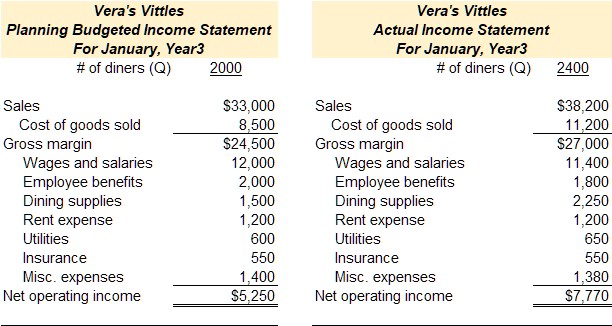

Flexible budgets
Planning budgets are prepared before the period begins and based on the planned level of activity for the period. At the end of the period, the actual level of activity as well as the actual financial results are known. If the planned budgeted activity is different than the actual activity, the planning budget cannot be used to evaluate performance during the period. Instead, a flexible budget must be prepared.
A flexible budget is the planning budget reforecasted using the actual level of activity instead of the planned level of activity. The flexible budget uses the same cost formulas as the planning budget but is prepared using the actual sales quantity as the cost driver. The reforecasted flexible budget adjusts revenue and expenditure targets to match the actual level of activity. Reforecasting enables the user to compare flexible budget targets to actual results and evaluate actual performance.
Video Illustration 3: Preparing a flexible budget
In December, Vera estimated approximately 2,000 diners would eat at the restaurant in January. She prepared a planning budget based on 2,000 diners. During January, Vera actually served 2,400 diners. Her revenue and cost formulas are given in the chart below. Prepare a flexible budgeted income statement.

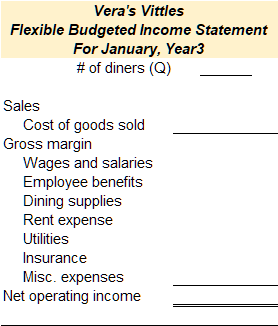

Flexible budget variances
Flexible budget variances are used in the performance evaluation phase. A variance is any discrepancy found when two items are compared. There are two main types of variances evaluated when flexible budgets are analyzed—activity variances and revenue or spending variances. Variances are classified as favorable or unfavorable depending on the perceived effect of the difference on the organization. For example, a variance resulting in an increase in revenue would be considered favorable whereas a variance resulting from an increase in expenses would be considered unfavorable.
Activity variances are the difference between the planning budget and the flexible budget. Activity variances are solely the result of changing the activity level from the planning quantity used for the planning budget to the actual quantity used for the flexible budget.
Spending and revenue variances are the difference between the flexible budget and the actual financial results. Spending and revenue variances are used to evaluate how well the organization did at achieving revenue, cost, and profit targets.
Video Illustration 4: Analyzing activity variances and revenue/spending variances found in flexible budgeting
For this illustration, assume that Vera wants to analyze activity variances and revenue/spending variances found when the planning budget, flexible budget, and actual results are compared. Prepare a flexible budget performance evaluation report detailing these variances.
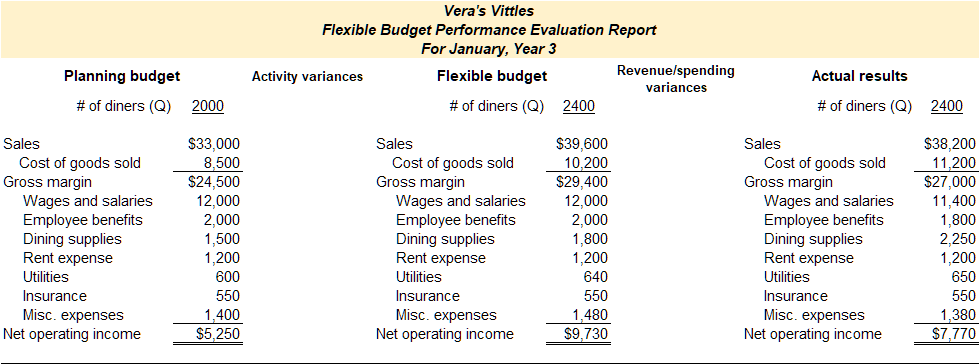

Practice Video Problems
Practice Video Problem 1: Preparing a planning budget
Wanda Wallace owns ReStore a furniture repair and restoration shop. Her sales have increased recently due to a renewed interested in reclaimed and restored furniture made popular on cable television. While the number of furniture repairs has steadily increased, Wanda is concerned that profits are not increasing at the same pace. She decided to prepare a planning budget for March to set revenue and expense targets for the shop. She expects to repair 120 pieces of furniture during March. She developed the following revenue and cost formulas for the shop.
Required 1: Prepare ReStore’s planning budgeted income statement for March.
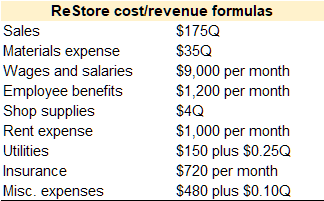
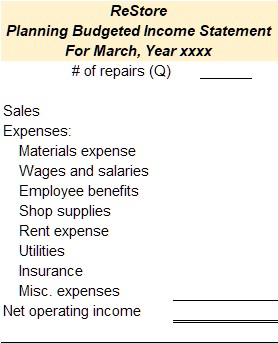

Practice Video Problem 2: Preparing a flexible budget
The March planning budget for Wanda’s furniture repair shop, ReStore, was prepared in the first practice video problem. On April 1st the actual results for the month of March were available. She originally planned to repair 120 pieces of furniture during March but she actually repaired 145 pieces of furniture. Using the revenue and cost formulas for the shop, prepare a flexible budget for March.
Required 1: Prepare ReStore’s flexible budget for March.

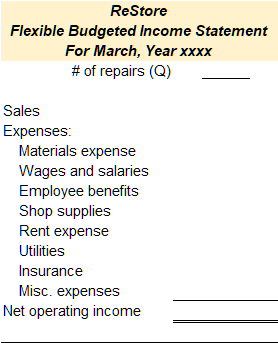

Practice Video Problem 3: Prepare a flexible budget performance evaluation report and analyze the variances
The March planning budget and flexible budget for Wanda’s furniture repair shop, ReStore, were prepared in the first two practice video problems. On April 1st the actual results for the month of March were available. She originally planned to repair 120 pieces of furniture during March but she actually repaired 145 pieces of furniture.
Required 1: Using the data provided from the first two practice video problems prepare a flexible budget performance evaluation report and analyze the variances.
